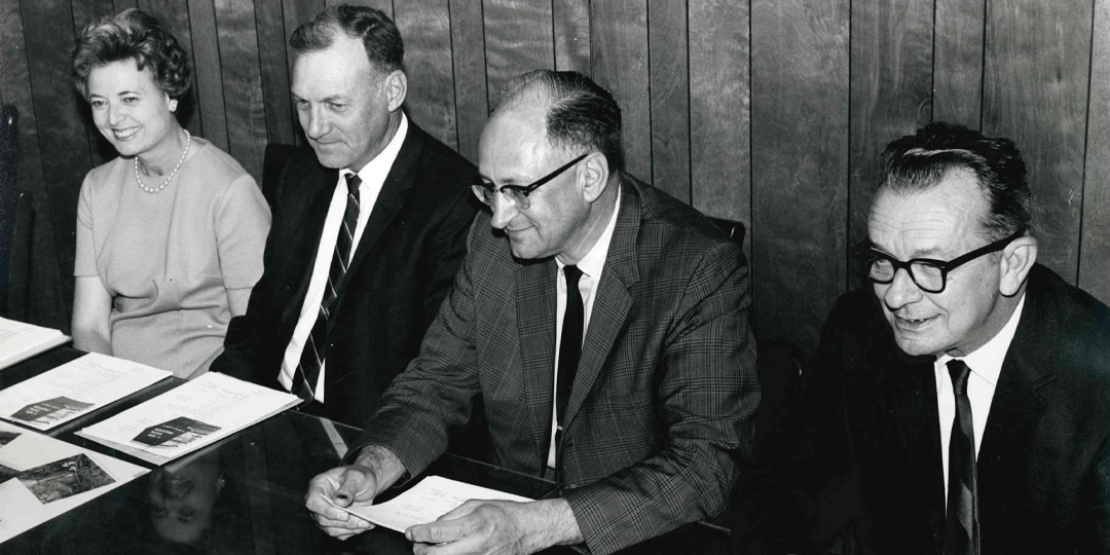Dr. Thurman Brock was a part of Craven Community College's story from the very beginning. His first day on the job was Aug. 15, 1961 as the inaugural Director of Vocational Education for Craven County Schools. He went on to become the College's first president, serving April 23, 1968–December 31, 1989.
To help preserve his institutional knowledge from those early years, Dr. Brock wrote an 18-part history of the College in 1984-85 for the school newspaper, "The Panther."
On January 16,1967, a meeting of local citizens was held at the New Bern Holiday Inn for the purpose of developing plans for the establishment of a technical institute in Craven County. The Craven unit of Lenoir County Community College had been in operation since July 1, 1965. Those in attendance were: Mr. Lynn Kelso, Chairman of the local advisory committee; Mr. Albert Salem, Vice Chairman of the advisory committee; Senator Sam Whitehurst; Representative R.C. Godwin; Representative James Sugg; Superintendent R.L. Pugh, Craven County School; D.L. Ward, Attorney L.E. Staton, Extension Director for the Craven unit; Lewis (Steve) Redd, Evening Director of the Craven Unit; Unit Director Thurman Brock; and Ned Delamar representing the N.C Department of Community Colleges.
At the meeting, plans were developed to submit a local referendum to the voters of Craven County to secure the required approval for the conversion of the Craven unit of Lenoir County Community College to an independent technical institute. To accomplish our objective required permission from the State Broad of Education and the North Carolina General Assembly gave its approval on May 31, 1967, and on July 6, 1967, the State Board of Education also granted us permission to proceed with our plans. On July 20, 1967, Mr. Lynn Kelso wrote a letter to Mr. L. B. Pate, Chairman of the Craven County School Board, requesting the County School Board support our request. At this time we were sponsored by the county schools who are also acted as disbursing agent for all county funds appropriated for use by the referendum in the amount $500,000 for capital construction and for a 10 cents levy per $100in property valuation to be used for operating expenses.
At this time Mr. R. L. Pugh had retired (July 1,1967) and Mr. Hiram Mayo, County Schools Superintendent, made our request in writing to the county commissioners. Chairman D. L. Stallings received on our behalf on August 11.1967. Also, Mr. Mayo’s letter request that the issues be submitted to the voters of Craven County on or before December 1, 1967.
There was another meeting held at the Holiday Inn in late August 1967. Also, Mr. Mayo Superintendent Pugh, Superintendent Mayo, Superintendent MacDonald, Mr. Kelso, Mr. Larry Pate, and I discussed the purposed plan for a local bond referendum and tax levy for a technical institute. I do not recall the exact date of this meeting, but it was the consensus of this group that the bond referendum should also include 5 million to be equally divided between the County School System and the New Bern City Schools. The county planned to use its 2.5 million for a new high school in Havelock and a new high school in western Craven County. The city school system was to use it’s 2.5. million for the construction of the H. J. MacDonald Junior High School.
The County Commissioners approved the total request. Tuesday, December 5, 1967, was selected as the voting date for the $5.5 million bond referendum. Also on the ballot was 10 cents per $100 valuation for support of the technical institute. The 10 levy and the 5.5 million were both approved by the voters on December 5, 1967.
For Craven County to have to have its own technical institute, which was to become Craven Community College, had taken six long years of planning and hard work by many citizens. Among those who worked so diligently on this project were Mr. Olin Wright, Executive Director of New Bern Chamber of Commerce; Mr. D.L. Stallings; Mr. R.L. Pugh, Mr. H.J. MacDonald; Mr. Harry Vatz; Mr. Don Deichnann; Mr. Albert Salem; Mr. Lynn Kelso; Mrs. Evelyn Haire; Mr. D.L. “Libby” Ward; Representative R.C. Godwin; Mr. Bill Dawson; and Mrs. Donald Weatherington.
There were many, many others, but this is the group of names that lingers in my memory. Also, Governor Dan Moore, State Director of Community College Dr. I. E. Ready; Dr. Dallas Herring, Chairman of the State Board of Education; Mr. Dan Wise, first president of Lenoir Community College; and Dr. Ben Fountain, second president of Lenoir Community College, were all very helpful and supportive of our efforts. To all these individuals I will always be grateful. These are the people who worked long and hard hours to make Craven Community College a reality.
Many of these individuals are not living now. However, they will live forever in my memory. Their kind words of support and encouragement were greatly appreciated, especially at those moments when our efforts discouraging. There were many discouraging moments. However, these fine individuals with a vision for a better future for all Craven County citizens seemed to provide encouragement at the moment it was it was most needed.
If those individuals were living today they would be proud of Craven Community College and the thousands of citizens who have benefited from the fruits of their labors. I shall always do everything within my power to assure that Craven will always be the kind of community college in which they and generations to come can take pride.
During this period of time, the Craven unit was operating at 219-223 Tryon Place Drive. Also, the Croatan (Leona) Elementary School was being used for two classroom and three shops for carpentry, welding and the machinist program. It was a banner year for the College. We were on our way to a brighter future in Craven County.
